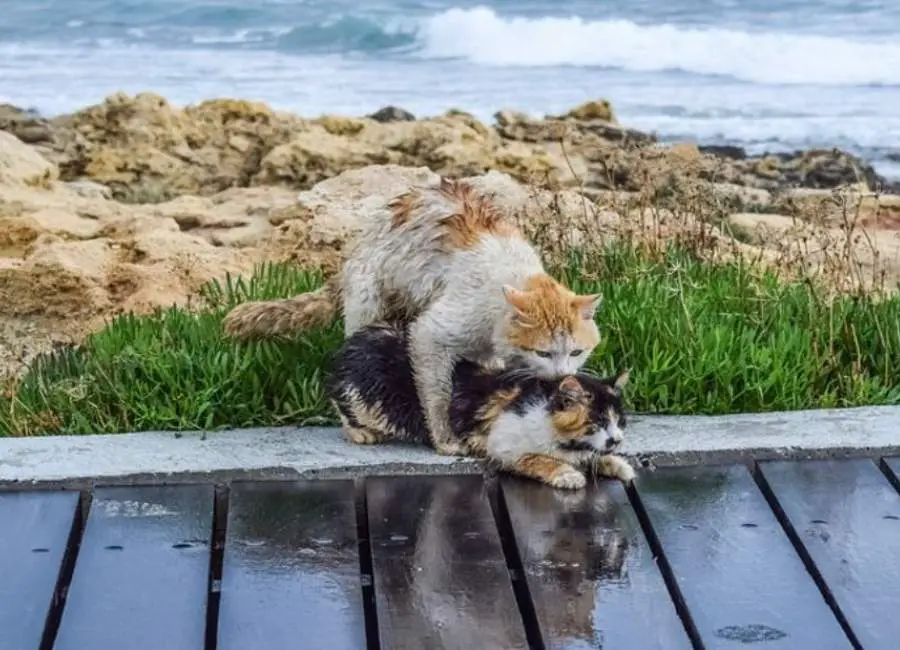10 Potential Female Cat Behavior After Mating

Female cats are fascinating creatures who demonstrate unique behaviors, especially after mating.
Yet, many cat owners are unaware of these behaviors and their significance, which can lead to confusion and worry.
In this blog post, we’ll take a closer look at the behavior of female cats after mating, and explore what it all means.
Female Cat Behavior After Mating
The following are some common female cat behavior after mating:
1. Attention-seeking
Some female cats may want greater attention from their owners after mating.
They might lick their owners’ faces, purr more than usual, or even sit on their laps.
The cat uses this activity to feel safe and secure following the stressful physical and psychological experience of mating.
2. Marking
Following mating, female cats may mark their territory by urinating outside of the litter box.
They use this activity to demarcate their domain and demonstrate their supremacy.
This activity can indicate a urinary tract infection or another medical condition if it becomes excessive or persists for more than a few days.
3. Restlessness
Particularly if they are unfamiliar with mating or if the mating was very abrasive, female cats may feel restless and disturbed after mating.
They might pace, meow more frequently than normal, and appear unable to relax.
Often, this behavior is transient and will stop in a few hours or days.
4. Licking
Female cats frequently lick their vaginal region excessively after mating.
This behavior keeps the environment tidy and is very natural.
However, it is preferable to visit a veterinarian as there could be an underlying medical concern if the licking becomes extreme or the cat appears uncomfortable.
5. Hiding behavior
After mating, some female cats would flee to a secluded hiding place. The impulse to defend oneself and one’s future progeny drives this behavior.
It is best to keep a close eye on your cat’s behavior if she begins to hide for an extended period of time to make sure she is not going through any problems or medical issues.
6. Vocalization
After mating, female cats could make more noise than usual. If they are in agony or discomfort, they may meow, yowl, or even scream.
This behavior is a typical reaction to the physiological and psychological changes brought on by mating.
7. Nesting behavior
After mating, a female cat who is pregnant could start building a nest for her babies.
Gathering blankets and other soft objects to make a warm space for her young is part of this habit.
See a veterinarian if you think your cat could be pregnant to make sure she gets the care and nutrients she needs.
8. Sleepiness
Female cats may become exhausted and sleep more than normal after mating. This behavior conserves their energy and is quite normal.
Nonetheless, it is best to get advice from a veterinarian if your cat seems unusually lethargic or seems to be in pain.
9. Appetite changes
Following mating, female cats’ appetites could vary.
They might consume more or less food than normal or have a penchant for particular food groups.
This tendency normally only lasts a few days and will go away.
10. Aggressive behavior
After mating, female cats are more likely to act aggressively, especially if they feel threatened or if other cats approach them.
When other cats approach too closely, they may hiss, snarl, or even attack.
This habit serves as a cat’s natural protection mechanism to guard against potential dangers.
Importance of monitoring female cat behavior after mating
There are several reasons why monitoring a female cat’s behavior after mating is important:
- Pregnancy: If the mating was successful, the female cat may become pregnant. Monitoring her behavior can help identify any changes or symptoms that could indicate pregnancy, such as increased appetite, nesting behavior, or decreased activity levels.
- Health concerns: Female cats can experience health complications after mating, such as infections or injuries. Monitoring her behavior can help identify any signs of discomfort, pain, or illness that require attention from a veterinarian.
- Behavioral changes: Mating can cause significant changes in a female cat’s behavior, including changes in activity levels, appetite, and mood. Monitoring her behavior can help identify any abnormal or concerning changes that may require intervention.
- Preventing unwanted litters: If the female cat is not intended to breed, monitoring her behavior can help prevent a potentially unwanted litter. Early identification of pregnancy and timely spaying can prevent unintended breeding.
- Early socialization: If the female cat becomes pregnant, early socialization is important for the health and development of the kittens. Monitoring her behavior can help ensure that she is comfortable and relaxed with her new situation, which can help promote positive interactions with the kittens.
- Ensuring proper nutrition: Pregnant cats require a specific diet to support the growth and development of their kittens. By monitoring the female cat’s behavior, you can ensure that she is eating enough food and receiving the proper nutrients.
Overall, monitoring a female cat’s behavior after mating is important for her health, the health and welfare of any potential offspring, and for preventing unwanted breeding.
Learn more about cat care tips.
How to manage female cat behavior after mating
After a female cat mates with a male, her behavior can be unpredictable and, in some cases, aggressive.
Here are some tips on how to manage a female cat’s behavior after mating:
- Give her space: After mating, a female cat may be irritable and want to be left alone. Provide a quiet, secluded area for her to rest and recuperate.
- Observe her behavior: Keep a close eye on the female cat’s behavior. If she is particularly agitated or shows signs of pain or discomfort, contact a veterinarian.
- Provide food and water: Make sure the female cat has access to food and water at all times. She may not want to eat right away, but it is important to encourage her to stay hydrated.
- Keep her indoors: To prevent her from mating again and potentially getting pregnant, keep the female cat indoors for at least a few days after mating.
- Consider spaying: If you do not plan to breed your cat, it is recommended to spay her. This will not only prevent unwanted litters but also reduce the risk of certain health issues.
By following these tips and closely monitoring the cat’s behavior, you can help manage a female cat’s behavior after mating and ensure she stays healthy and happy.
Learn more about abnormal cat behavior.
Conclusion
Female cats exhibit fascinating behaviors after mating, and understanding these behaviors is essential for any cat owner.
From increased agitation to marking behaviors, female cats communicate a lot through their actions.
By recognizing these behaviors, owners can provide better care and comfort to their feline friends.
It’s also essential to keep in mind that spaying or neutering a cat can alleviate some of these behaviors and contribute to its overall health and longevity.
